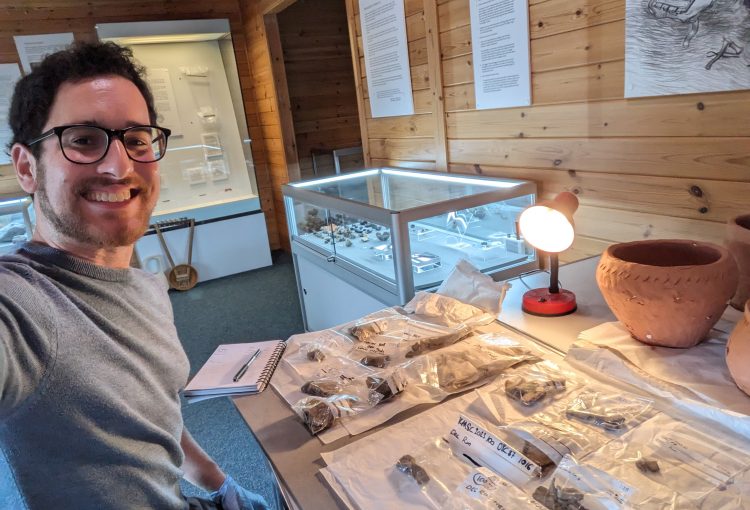The People Behind the Pots: Co-curating a display of Iron Age pottery sherds at the Scottish Crannog Centre
David C. Weinczok
Sitting at a table with hundreds of pottery sherds in front of me and having never co-curated a museum display before, I fell back onto more familiar ground: storytelling. People won’t retain every little detail from a display – I certainly don’t! The question therefore became, how can I craft a story which visitors can hold onto as they continue their journey through the Scottish Crannog Centre?
The sherds in question came from two different crannogs: Oakbank on Loch Tay (within sight of the Crannog Centre), and Dun Bharabhat in Lewis. That alone provided a clear way to divide the contents of the case, but it also raised a second question: how do the sherds speak to similarities and differences between the two crannogs?
Generally, the Oakbank sherds are chunkier and undecorated, while the Dun Bharabhat sherds are thinner and often decorated with motifs. These motifs include geometric shapes, parallel lines, crescent-shaped impressions from fingernails, zigzags, small dots, and more.
I decided that sherds from Oakbank should go on the left, which is where most eyes will be drawn to first, and that sherds from Dun Bharabhat should go on the right. I then scoured the many, many bags filled with sherds from both crannogs to find the best examples of each motif and section of pottery – base, body, and rim. This was admittedly subjective, and I simply chose the pieces I thought were the best visual examples of their type. I didn’t want to overwhelm with too many examples, so two or three of each would suffice. Favourites in hand, I arranged them into small clusters on their respective side of the display case. As a general principle, larger undecorated pieces should go further back and smaller, finely decorated pieces should be near the front.
Luckily for me, that very morning a box had been dropped off at the Crannog Centre containing several modern, experimental recreations of Iron Age pottery. Even more luckily, they fit perfectly into the display case and provided crucial context for the clusters of sherds, giving visitors an idea of how it would all have come together for each style. The Crannog Centre’s curator, Amy Stewart, also managed to track down a mirrored panel to put at the back of the case. This made it possible to see multiple sides of each sherd, and created a cool ‘infinity’ effect with the modern pots. A little flair can go a long way!


However, one section still sat empty: the centre. This was by design. While the Oakbank and Dun Bharabhat pots are very visually distinct from one another, one fundamental fact unites them: they were crafted by people every bit as complex and imaginative as us. Rather than discussing the pottery in isolation from their social contexts, I wanted to emphasise it. What better way to achieve this than through the instant connection that forms when you see the fingerprints of a past person?
Astonishingly, finger marks from people who lived, loved, and laboured some 2,000 years ago survive on several of the sherds from Dun Bharabhat. This was the common element, and to emphasise it I choose to raise the finger-marked sherds on a small platform, the only objects in the case to get this treatment. My hope is that no matter what else visitors remember from the case, they will walk away having made a connection to the people behind the pots.
Thank you very much to the Scottish Crannog Centre, specifically curator Amy Stewart, for inviting me to co-curate this display.





